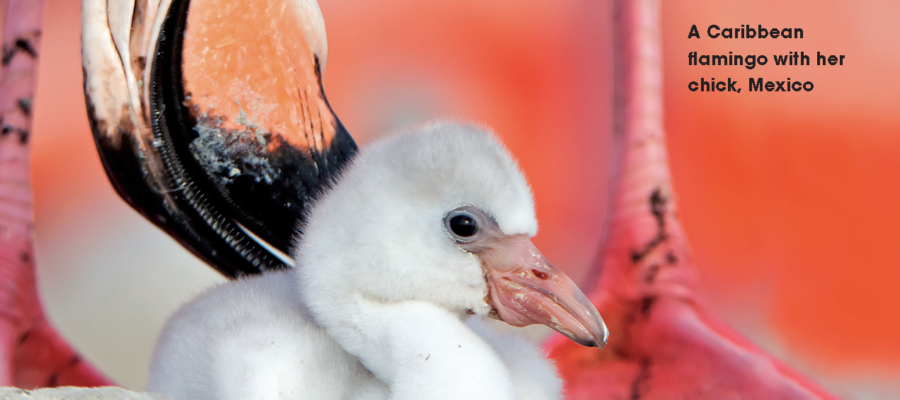In this series of blog posts for 2020, Katherine shares ideas for creative mini-project lesson plans that encourage learners to take an interest in aspects of nature. The series will motivate learners to feel wonder, respect, and love for the natural world. Learners will develop traditional skills of reading, writing, speaking and listening and 21st-century life skills to help them grow into responsible citizens.
We love animals
The first blog post of the series starts with learners developing visual literacy through a high impact photo of a mother flamingo with her chick. Learners then follow a step-by-step supported writing task, before working in pairs and a group to make and play a matching pairs card game.
| Focus: Animals Skills: Listening, speaking, reading, writing, visual literacy, creativity, critical thinking, collaboration Interaction: individual, pair work and group work Materials: Two pieces of white card per learner, colored crayons Evaluation: A checklist |
The photo
Display the photo for the learners to see. Ask a few questions about it. Start with specific questions and move on to questions that require more critical or creative thinking: What are these animals? How many are there? What colors can you see? Can you name any parts of the birds’ bodies? How are the two birds the same? How are they different? What’s the mum doing? How is the baby feeling? Where do you think the birds are?

Background information
Read the text aloud, pausing before the words in bold for learners to suggest the next word.
This photo shows two birds. These birds are called flamingoes. The big flamingo is the mother. The small flamingo is the baby. A baby bird is called a chick. The mother has two long, pink legs. She has pink feathers too. The baby has white feathers. The mother’s beak is big. It’s white, orange and black. The baby’s beak is pink. Flamingoes can fly but they can’t jump. I love this photo. Flamingoes are beautiful!
Project
In this project, learners create a matching card game on the theme of mother and baby animals. They work individually, in pairs and then in groups.
Step 1. Language preparation
Copy this skeleton text on the board.
This picture shows two __________. The big __________ is the mother. The small __________ is the baby. A baby __________ is called a __________. The mother has __________ , __________legs. She has __________ __________ too. The baby has ____________________ . The mother’s __________ is/are __________. The baby’s __________ is/are __________. __________can __________ but they can’t __________. I love this photo. __________ are __________!
Remove the photo. Then ask learners to complete the text with the information they can remember about the flamingoes.
Step 2. Drawing and writing
Explain to learners that they are going to draw and write about a mother and baby animal of their choice. Provide each learner with two pieces of paper or card.
If necessary, elicit animal vocabulary and write it on the board. This stage will add support and help learners choose an animal.
For example: cat – kitten, dog – puppy, horse – foal, chicken – chick, sheep – lamb, pig – piglet, duck – duckling, cow – calf, bear – cub, deer – fawn, eagle – fledgling, elephant – calf, fox – cub, goat – kid, monkey – infant, kangaroo – joey, lion – cub, parrot – chick, tiger – cub, swan – cygnet, frog – tadpole, turtle – hatchling, zebra – foal.
Each learner chooses a different* animal. They draw and color** a picture of a mother and a baby.
*This is an opportunity to encourage stronger learners to choose more challenging animals to draw, leaving easier animals for learners who need more support.
**This stage could be set as homework to avoid spending too much coloring time in class.
In pairs, learners help each other to write a text about their animal. They use the skeleton text as a model, completing it with information about their animal. If necessary write an example on the board, choosing an animal that hasn’t been chosen and asking learners to help you complete the missing information with appropriate words.
Step 3. Making and playing the game
Collect all of the cards with the pictures and texts. Together these form the matching pairs game.
- Stick all of the pictures face down on a wall, in rows and columns.
- Organize learners into two to four teams, A, B (C, D).
- Invite the first member of Team A to come up to the display and choose two cards. Turn them over and show them to the class. If they match (picture and text), Team A ‘wins’, so ‘keeps’ the cards and has another turn. If they don’t match, stick them back in place and invite the first member of team B to choose two cards.
- Continue in this way, inviting members of each team to come up in turn, keeping the cards they win until there are no cards left.
- The winning team is the team with the most cards.
Evaluation
If you need to evaluate learners’ work, focus on the process of the whole activity and not only the end results. A checklist can be helpful. If you choose to use one, show it to learners and make sure they understand it before you start the activity so that they are aware of your expectations at every stage.
Suggested checklist
| Name: ___________________ | Yes | No |
| Introduction | answered questions and participated | |
| Animal text | is complete | |
| is accurate | ||
| is neat | ||
| Animal drawing | is complete | |
| is neat | ||
| Worked well with partner | ||
| Participated in game |


